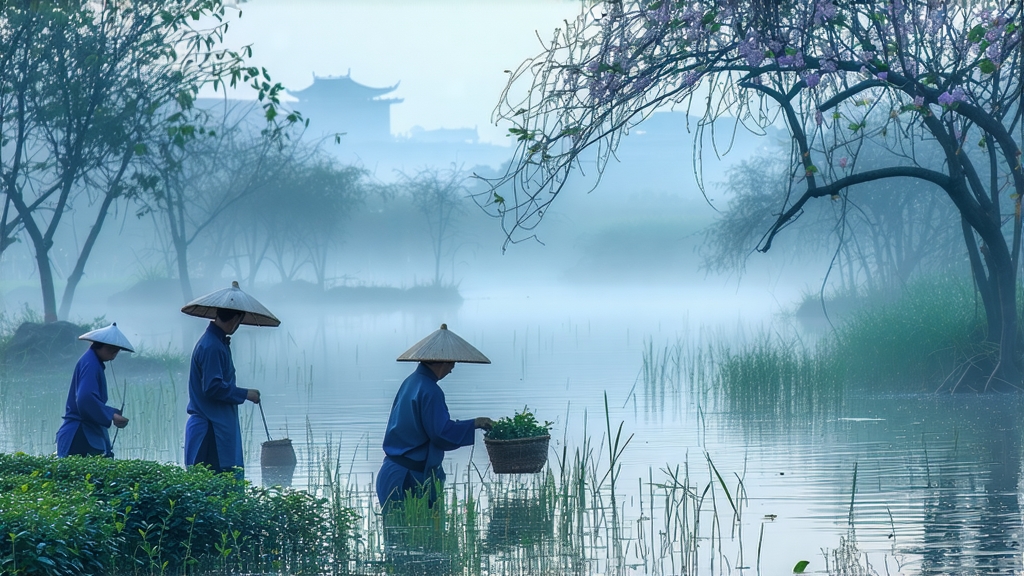
If green tea were a library of Chinese landscape poetry, Biluochun would be the slender scroll that unfurls the scent of spring water and mountain mist in a single brushstroke. Known in the trade as “Green Snail Spring,” this micro-leafed marvel from the lake-studded hinterland of Jiangsu Province carries five centuries of court gossip, maritime mispronunciation, and imperial infatuation inside its downy whorls. To the international drinker it offers a liquid lesson in how Chinese aesthetics compress geography, botany, and human touch into one translucent cup.
-
From Imperial Tribute to Global Glass
The story begins in the Ming dynasty, when tea masters around Dongting Mountain noticed that certain bushes growing cheek-to-jowl with peach, plum, and apricot trees produced leaves of uncanny fragrance. The blossoms cross-pollinated the tea, and the lake’s morning fog slowed photosynthesis, concentrating amino acids that translate into sweetness. In 1699 the Kangxi Emperor sampled the tea on his southern inspection tour, praised its “scary greenness” (the colour was so vivid it startled the eye), and renamed it Biluochun—“green snail of spring”—because the finished leaf resembled a tiny jade snail shell. For the next 250 years the entire crop was monopolised by the imperial household; only after the 1911 revolution did surplus trickle onto the Shanghai export market, where foreign buyers corrupted the name into “Pi Lo Chun.” Today the EU Protected Designation of Origin recognises only leaf harvested within a 12-km radius of Dongting’s East and West mountains, making it one of China’s first teas with legal terroir. -
Micro-Terroir: Lake, Stone, Blossom
Dongting Mountain is actually two limestone islands thrusting out of Taihu Lake like the humps of a submerged dragon. The soil is a friable mix of weathered shale and fossilised coral; drainage is so sharp that roots are forced to dive deep for minerals, accounting for the tea’s flinty backbone. Average annual humidity hovers at 80 %, and the diurnal temperature swing can exceed 10 °C within a single April day—conditions that coax the bushes into slow, flavour-stacking growth. Most farms intercrop rows of tea with fruit trees; fallen petals act as mulch while their volatile esters drift onto the leaf surface, giving Biluochun its signature floral top note that sommeliers liken to white Alba truffle. -
Cultivar Clones and Harvest Hierarchy
The original landrace is a diminutive shrub botanically labelled Camellia sinensis var. sinensis f. biluochun, locally nicknamed “Xiao Ye Wu Nong” (tiny-leaf, five-petals). Since the 1980s agronomists have released clonal upgrades—Dongting #1, #5, and #7—selected for cold tolerance and even higher aroma index. Purists insist only the heirloom strain delivers the haunting aftertaste called “yun,” a cooling sensation that starts on the tip of the tongue and migrates to the back of the throat like a distant temple bell. Picking begins when two-thirds of the buds are still closed, usually between the Qingming and Grain Rain solar terms (early April). One kilogram of finished tea demands 70,000 buds, all plucked before 9 a.m. while dew is still intact; any later and the sun wilts the fragile hairs that give the liquor its creamy opacity. -
The Six-Step Choreography of Hand-Firing
Within four hours of plucking the leaves enter a shed perfumed by the previous night’s charcoal embers. The craft protocol has remained unchanged since 1675:
a. Withering on bamboo trays for 30 minutes—just long enough for the edges to lose their brittleness.
b. Pan-killing green at 180 °C for 3–4 minutes; the master tosses 250 g portions in a wok the size of a cymbal, using only his bare fingers as sensors. When the leaf temperature hits 70 °C enzymes are neutralised, locking in the jade hue.
c. Rolling-spiral while the leaf is still scalding; thumb and forefinger twist each bud into a tight coil, a motion that ruptures cell walls and releases aromatic precursors.
d. First drying over a wicker brazier